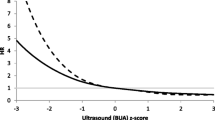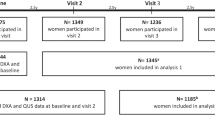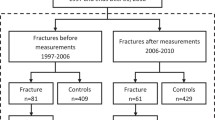Abstract
Summary
The fracture predictive value of quantitative ultrasound (QUS) may be modified by previous fracture status. Non-significant associations between QUS parameters and fracture risk were observed among frail older people with a history of fracture. These findings suggest that QUS measurements for frail older people might be more useful in those without a fracture history.
Introduction
Quantitative ultrasound has been shown to predict risk of fracture in various populations. However, this ability may be modified by the presence of previous fracture in very frail older people.
Methods
We assessed bone strength by QUS and clinical risk factors at baseline for 1,982 institutionalised older people. Fractures were ascertained for 2 years from baseline and validated by X-ray reports.
Results
Study participants were very old (mean age = 85.7 ± 7.1 years) and frail (70% using walking aids). Forty-five percent reported a history of fracture. During a mean follow-up period of 1.64 years, 335 participants suffered a fracture or fractures. Fracture rates were significantly higher in participants with a history of fracture compared with those without a history of fracture (16.0 vs 9.2 per 100 person years, p < 0.001). Significant associations between fracture risk and QUS parameters (broadband ultrasound attenuation and velocity of sound) were observed among participants without a history of fracture (both p < 0.01), but not among those who had a fracture history (both p ≥ 0.7).
Conclusions
In very frail older people, QUS measurements may be more useful for assessing fracture risk in those without a history of fracture after age 50.


Similar content being viewed by others
References
Dennison E, Cooper C (2000) Epidemiology of osteoporotic fractures. Horm Res 54 [Suppl 1]:58–63
Osteoporosis consensus statement, Australia. MJA http://www.mja.com.au/public/guides/osteo/whatis.html
Access Economics Pty Limited (2001) The burden of brittle bones: costing osteoporosis in Australia. Prepared for Osteoporosis Australia
Bauer DC, Gluer CC, Cauley JA et al (1997) Broadband ultrasound attenuation predicts fractures strongly and independently of densitometry in older women. A prospective study. Study of Osteoporotic Fractures Research Group. Arch Intern Med 157:629–634
Hans D, Dargent-Molina P, Schott AM et al (1996) Ultrasonographic heel measurements to predict hip fracture in elderly women: the EPIDOS prospective study. Lancet 348:511–514
Khaw KT, Reeve J, Luben R et al (2004) Prediction of total and hip fracture risk in men and women by quantitative ultrasound of the calcaneus: EPIC-Norfolk prospective population study. Lancet 363:197–202
Pluijm SM, Graafmans WC, Bouter LM et al (1999) Ultrasound measurements for the prediction of osteoporotic fractures in elderly people. Osteoporos Int 9:550–556
Porter RW, Miller CG, Grainger D et al (1990) Prediction of hip fracture in elderly women: a prospective study. BMJ 301:638–641
Huang C, Ross PD, Yates AJ et al (1998) Prediction of fracture risk by radiographic absorptiometry and quantitative ultrasound: a prospective study. Calcif Tissue Int 63:380–384
Krieg MA, Cornuz J, Ruffieux C et al (2006) Prediction of hip fracture risk by quantitative ultrasound in more than 7000 Swiss women > or = 70 years of age: comparison of three technologically different bone ultrasound devices in the SEMOF study. J Bone Miner Res 21:1457–1463
Bouxsein ML, Radloff SE (1997) Quantitative ultrasound of the calcaneus reflects the mechanical properties of calcaneal trabecular bone. J Bone Miner Res 12:839–846
Lee SC, Coan BS, Bouxsein ML (1997) Tibial ultrasound velocity measured in situ predicts the material properties of tibial cortical bone. Bone 21:119–125
McGrother CW, Donaldson MM, Clayton D et al (2002) Evaluation of a hip fracture risk score for assessing elderly women: the Melton Osteoporotic Fracture (MOF) study. Osteoporos Int 13:89–96
Visentin P, Ciravegna R, Uscello L et al (1995) Site-specific relative risk of fractures in the institutionalized elderly. Gerontology 41:273–279
Black DM, Steinbuch M, Palermo L et al (2001) An assessment tool for predicting fracture risk in postmenopausal women. Osteoporos Int 12:519–528
Porthouse J, Birks YF, Torgerson DJ et al (2004) Risk factors for fracture in a UK population: a prospective cohort study. QJM 97:569–574
Mallmin H, Ljunghall S, Persson I et al (1993) Fracture of the distal forearm as a forecaster of subsequent hip fracture: a population-based cohort study with 24 years of follow-up. Calcif Tissue Int 52:269–272
Kotowicz MA, Melton LJ III, Cooper C et al (1994) Risk of hip fracture in women with vertebral fracture. J Bone Miner Res 9:599–605
Zochling J, Sitoh YY, Lau TC et al (2002) Quantitative ultrasound of the calcaneus and falls risk in the institutionalized elderly: sex differences and relationship to vitamin D status. Osteoporos Int 13:882–887
Molloy DW, Alemayehu E, Roberts R (1991) Reliability of a Standardized Mini-Mental State Examination compared with the traditional Mini-Mental State Examination. Am J Psychiatry 148:102–105
Lord SR, Clark RD, Webster IW (1991) Physiological factors associated with falls in an elderly population. J Am Geriatr Soc 39:1194–1200
Han TS, Lean ME (1996) Lower leg length as an index of stature in adults. Int J Obes Relat Metab Disord 20:21–27
Sambrook PN, Cameron ID, Chen JS et al (2007) Influence of fall related factors and bone strength on fracture risk in the frail elderly. Osteoporos Int 18:603–610
Ross PD, Davis JW, Epstein RS et al (1991) Pre-existing fractures and bone mass predict vertebral fracture incidence in women. Ann Intern Med 114:919–923
Lindsay R, Silverman SL, Cooper C et al (2001) Risk of new vertebral fracture in the year following a fracture. JAMA 285:320–323
Cummings SR, Nevitt MC, Browner WS et al (1995) Risk factors for hip fracture in white women. Study of Osteoporotic Fractures Research Group. N Engl J Med 332:767–773
Robinson CM, Royds M, Abraham A et al (2002) Refractures in patients at least forty-five years old. A prospective analysis of twenty-two thousand and sixty patients. J Bone Joint Surg Am 84:1528–1533
Gunnes M, Mellstrom D, Johnell O (1998) How well can a previous fracture indicate a new fracture? A questionnaire study of 29,802 postmenopausal women. Acta Orthop Scand 69:508–512
Klotzbuecher CM, Ross PD, Landsman PB et al (2000) Patients with prior fractures have an increased risk of future fractures: a summary of the literature and statistical synthesis. J Bone Miner Res 15:721–739
Durosier C, Hans D, Krieg MA et al (2007) Combining clinical factors and quantitative ultrasound improves the detection of women both at low and high risk for hip fracture. Osteoporos Int 18:1651–1659
Hayes WC, Myers ER, Morris JN et al (1993) Impact near the hip dominates fracture risk in elderly nursing home residents who fall. Calcif Tissue Int 52:192–198
Lotz JC, Hayes WC (1990) The use of quantitative computed tomography to estimate risk of fracture of the hip from falls. J Bone Joint Surg Am 72:689–700
Cooper C, Barker DJ, Morris J et al (1987) Osteoporosis, falls, and age in fracture of the proximal femur. Br Med J (Clin Res Ed) 295:13–15
Acknowledgements
The authors would like to thank Ms. J. Schwarz (Research Co-ordinator) and Ms. J. Makaroff (Research Assistant) for their efforts in co-ordinating the study and collecting the data. This study was supported by grants from the Australian National Health and Medical Research Council and Osteoporosis Australia.
Conflicts of interest
None.
Author information
Authors and Affiliations
Corresponding author
Rights and permissions
About this article
Cite this article
Chen, J.S., March, L.M., Cumming, R.G. et al. Role of quantitative ultrasound to predict fracture among institutionalised older people with a history of fracture. Osteoporos Int 20, 105–112 (2009). https://doi.org/10.1007/s00198-008-0638-7
Received:
Accepted:
Published:
Issue Date:
DOI: https://doi.org/10.1007/s00198-008-0638-7




